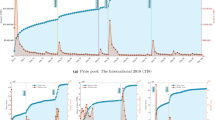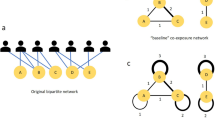Abstract
The collective behavior describing spontaneously emerging social processes and events is ubiquitous in both physical society and online social media. The knowledge of collective behavior is critical in understanding and predicting social movements, fads, riots, and so on. However, detecting, quantifying, and modeling the collective behavior in cascading systems at large scale are seldom explored. In this paper, we examine a real-world online social media with more than 1.7 million information spreading records. We observe evident collective behavior in information cascading systems and then propose metrics to quantify the collectivity. We find that previous information cascading models cannot capture the collective behavior in the real-world data and thus never utilize it. Furthermore, we propose a comprehensive generative framework with a latent user interest layer to capture the collective behavior. Our framework accurately models the information cascades with respect to dynamics, popularity, structure, and collectivity. By leveraging the knowledge behind collective behavior, our model successfully predicts the popularity and participants of information cascades without temporal features or early stage information. Our framework may serve as a more generalized one in modeling cascading systems, and, together with empirical discovery and applications, advance our understanding of human behavior.










Similar content being viewed by others
Notes
The 5 periods include: morning(6:00–10:00), noon(10:00–14:00), afternoon(14:00–18:00), evening(18:00–22:00), and night(22:00–6:00 nextday).
References
Banerjee S, Agarwal N (2012) Analyzing collective behavior from blogs using swarm intelligence. Knowl Inf Syst 33(3):523–547
Bian J, Yang Y, Chua, TS (2014) Predicting trending messages and diffusion participants in microblogging network. pp 537–546
Calabrese F, Giusy DL, Ratti C (2010) Human mobility prediction based on individual and collective geographical preferences. In: 2010 13th international IEEE conference on IEEE intelligent transportation systems (ITSC), pp 312–317
Candia J, González MC, Wang P, Schoenharl T, Madey G, Barabási A-L (2008) Uncovering individual and collective human dynamics from mobile phone records. J Phys A Math Theor 41(22):224015
Cheng J, Adamic L, Dow PA, Kleinberg, JM, Leskovec J (2014) Can cascades be predicted? pp 925–936
Cohen R, Havlin S, Ben-Avraham D (2002) Efficient immunization strategies for computer networks and populations. Phys Rev Lett 91(24):247901
Crane R, Sornette D (2008) Robust dynamic classes revealed by measuring the response function of a social system. Proc Natl Acad Sci U S A 105(41):15649–53
Cui P, Jin S, Yu L, Wang F, Zhu W, Yang S (2013) Cascading outbreak prediction in networks:a data-driven approach. In: ACM SIGKDD international conference on knowledge discovery and data mining, pp 901–909
Dempster AP, Laird NM, Rubin DB (1977) Maximum likelihood from incomplete data via the EM algorithm. J Roy Stat Soc 39(1):1–38
Galuba W, Aberer K, Chakraborty D, Despotovic Z, Kellerer W (2010) Outtweeting the twitterers-predicting information cascades in microblogs. WOSN 10:3–11
Harris TE (1963) THE theory of branching processes. Springer, Berlin, pp 5–46
Iwata, T, Shah A, Ghahramani Z (2013) Discovering latent influence in online social activities via shared cascade poisson processes. In: ACM SIGKDD international conference on knowledge discovery and data mining, pp 266–274
Kobayashi R, Lambiotte R (2016) TiDeH: Time-dependent hawkes process for predicting retweet dynamics
Lehmann J, Gonçalves B, Ramasco JJ, Cattuto C (2011) Dynamical classes of collective attention in twitter. Comput Sci, 251–260
Li C, Te L, Yu J, Yeh MY (2017) Forecasting participants of information diffusion on social networks with its applications. Inf Sci 422:432–446
Lu Y, Yu L, Zhang T, Zang C, Cui P, Song C, Zhu W (2018) Collective human behavior in cascading system: discovery, modeling and applications. In: IEEE international conference on data mining
Mcgrew WC (1998) Culture in nonhuman primates? Annu Rev Anthropol 27(1):301–328
Mishra S, Rizoiu MA, Xie L (2016) Feature driven and point process approaches for popularity prediction. In: ACM international on conference on information and knowledge management, pp 1069–1078
Moore C, Newman MEJ (2000) Epidemics and percolation in small-world networks. Phys Revi E Stat Phys Plasmas Fluids Relat Interdiscip Top 61(5):5678
Myers SA, Leskovec J (2010) On the convexity of latent social network inference
R Dean M, Stouffer DB, Motter AE, Amaral LAN (2008) A Poissonian explanation for heavy tails in e-mail communication. Proc Nat Acad Sci USA 105(47):18153–18158
Rodriguez MG, Balduzzi D, Schölkopf B (2011) Uncovering the temporal dynamics of diffusion networks, pp 561–568
Rodriguez MG, Leskovec J, Schölkopf B (2013) Modeling information propagation with survival theory. In: International conference on machine learning, pp 666–674
Rouvray DH (2002) The rich legacy of half a century of the wiener index. Elsevier Ltd, Amsterdam, pp 16–37
Sastry N, Yoneki E, Crowcroft J (2009) Buzztraq: predicting geographical access patterns of social cascades using social networks. In: ACM Eurosys Sns Workshop, pp 39–45
Shen HW, Wang D, Song C, Barabási A (2014) Modeling and predicting popularity dynamics via reinforced Poisson processes. In: Twenty-eighth AAAI conference on artificial intelligence, pp 291–297
Tang L, Liu H (2009) Scalable learning of collective behavior based on sparse social dimensions. In: ACM conference on information and knowledge management, pp 1107–1116
Turner RH, Killian LM et al (1957) Collective behavior. Prentice-Hall, Englewood Cliffs
Yu L, Cui P, Song C, Zhang T, Yang S (2017) A temporally heterogeneous survival framework with application to social behavior dynamics. In: Proceedings of the 23rd ACM SIGKDD international conference on knowledge discovery and data mining. ACM, pp 1295–1304
Yu L, Cui P, Wang F, Song C, Yang S (2015) From micro to macro: uncovering and predicting information cascading process with behavioral dynamics. In: IEEE international conference on data mining, pp 559–568
Yu L, Cui P, Wang F, Song C, Yang S (2017) Uncovering and predicting the dynamic process of information cascades with survival model. Knowl Inf Syst 50(2):1–27
Zang C, Cui, P, Song C, Faloutsos C, Zhu W (2017) Quantifying structural patterns of information cascades. In: International conference on world wide web companion, pp 867–868
Zhang Q, Gong Y, Guo Y, Huang X (2015) Twenty-ninth AAAI conference on artificial intelligence, pp 403–409
Zhao Q, Erdogdu MA, He HY, Rajaraman A, Leskovec J (2015) SEISMIC: a self-exciting point process model for predicting tweet popularity. In: ACM SIGKDD international conference on knowledge discovery and data mining, pp 1513–1522
Acknowledgements
The authors thank anonymous reviewers for many useful discussions and insightful suggestions. This work was supported in part by National Key R&D Program of China (No. 2018AAA0102004), National Natural Science Foundation of China (Nos. U1936219, 61772304, 61531006, U1611461), Beijing Academy of Artificial Intelligence (BAAI ), and a grant from the Institute for Guo Qiang, Tsinghua University. Thanks for the research fund of Tsinghua-Tencent Joint Laboratory for Internet Innovation Technology and the Young Elite Scientist Sponsorship Program by CAST. Song was partly supported by the National Science Foundation (IBSS-L-1620294). Wenwu Zhu is the corresponding author. All opinions, findings, and conclusions in this paper are those of the authors and do not necessarily reflect the views of the funding agencies.
Author information
Authors and Affiliations
Corresponding author
Additional information
Publisher's Note
Springer Nature remains neutral with regard to jurisdictional claims in published maps and institutional affiliations.
Rights and permissions
About this article
Cite this article
Lu, Y., Yu, L., Zhang, T. et al. Exploring the collective human behavior in cascading systems: a comprehensive framework. Knowl Inf Syst 62, 4599–4623 (2020). https://doi.org/10.1007/s10115-020-01506-8
Received:
Revised:
Accepted:
Published:
Issue Date:
DOI: https://doi.org/10.1007/s10115-020-01506-8




